m or m. - Abbreviation for meter.
![]()

machicolation - In the architecture of castles, an opening in the floor of an overhanging gallery through which defenders dropped stones and boiling liquids on attackers.
(pr. mə-CHI-kə-LAY-shən)
Also see arms & armor, crenelation, Middle Ages, and tower.
macramé - Long cords knotted to form a pattern. This is an old craft revived to great popularity in the 1960s and 1970s.
(pr. MAK-rə-MAY)
maculate - Spotted; stained; blotched. Or, defiled; impure. The opposite of immaculate.
(pr. MAK-yə-lət)
Also see ablaq, brindled, cleaning art, clean up, dot, maculate, pattern, piebald, punctate, and variegated.
madder lake - A particular red pigment produced with the synthetic coal-tar dye, alizarin.
Related resource:
madrasa - In Islamic tradition, a combined school and mosque.
(pr. mə-DRAH-sə)
magazine - A periodical, a publication typically printed on paper, containing a collection of articles, pictures, or other features. In architecture, a room or building designed for storage.
Also see mass media and tear sheet.
![]()

magenta - A color also known
as fuchsia and hot pink; a moderate to vivid purplish red or pink,
named after the town of  Magenta,
in northwest Italy. Magenta is one of the four colors in the four
color process for reproduction
color in print
called CMYK. The CMYK process
creates the color spectrum
using cyan, magenta,
yellow, and black.
Magenta,
in northwest Italy. Magenta is one of the four colors in the four
color process for reproduction
color in print
called CMYK. The CMYK process
creates the color spectrum
using cyan, magenta,
yellow, and black.
(pr. mə-JEN-tə)
magic lantern - A precursor
to the modern slide projector,
an optical instrument having
either a way to use sunlight or a candle 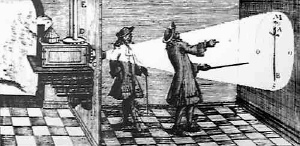 (and
later an oil lamp, "oxy-hydrogen limelight," or "arclight")
and a lens through which an
image painted
or printed on a glass plate
was projected and enlarged.
Early in the 15th century an Italian named Giovanni de Fontana
described a lantern to which
a picture was attached in such a way that it would project the
picture onto a wall. The first magic lanterns to employ lenses
were developed in the mid-17th century. Historians disagree about
who was the first to invent the device. It appears to have been
the product of a number of small improvements. By the early 19th
century numerous itinerant projectionists traveled around Europe
with magic lanterns and collections
of slides, putting on shows wherever they
(and
later an oil lamp, "oxy-hydrogen limelight," or "arclight")
and a lens through which an
image painted
or printed on a glass plate
was projected and enlarged.
Early in the 15th century an Italian named Giovanni de Fontana
described a lantern to which
a picture was attached in such a way that it would project the
picture onto a wall. The first magic lanterns to employ lenses
were developed in the mid-17th century. Historians disagree about
who was the first to invent the device. It appears to have been
the product of a number of small improvements. By the early 19th
century numerous itinerant projectionists traveled around Europe
with magic lanterns and collections
of slides, putting on shows wherever they 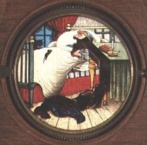 could
draw a paying audience. Multiple
projectors allowed for the dissolving of one image into another.
Some slides boasted special effects. Some had extra layers that
could be moved across each other. One of these, very popular with
children, was
could
draw a paying audience. Multiple
projectors allowed for the dissolving of one image into another.
Some slides boasted special effects. Some had extra layers that
could be moved across each other. One of these, very popular with
children, was The
Rat-Swallower. One
rat after another could be made to appear to jump into the open
mouth of a sleeping man! A narrative
sequence could be presented,
such as the one created in England about 1812 to tell the story
a battle between a British warship and a French one. A narrator
told the audience how it happened while the pictures were projected,
ending on an image of the French ship in flames. (Remind you of
the 2003 movie Master and Commander?) In the middle of
the 19th century, with the invention of photography and the availability of magic
lanterns for use in one's home, the number of magic lantern slides
produced increased tremendously. Commercially available sets of
slides often featured photographs of famous places and celebrities,
or actors performing allegories.
The popularity of magic lanterns ended with the invention of cinematography at the end of the 19th
century.
Related links:
Also see camera lucida, camera obscura, theater, zoetrope, and zoopraxiscope.
Magna - A line of painting products made by Bocour Artists Colors, 552 West 52nd Street, New York, NY 10019. Magna Plastic Colors are permanent pigments ground in an acrylic resin with solvents and plasticizer. They are miscible with turpentine as well as mineral spirits. They dry rapidly, leaving a mat finish. Magna Varnish is a transparent isolating varnish for use with Magna Plastic Colors and also useful as an isolating varnish in oil painting and some complex techniques. Without its use the Magna colors are too readily picked up by additional coats.
Examples:
Barnett Newman (American, 1905-1970), The Name II, 1950, Magna and oil on canvas, 104 x 94 1/2 inches (2.642 x 2.400 m), National Gallery of Art, Washington, DC. [Unfortunately, I can't tell you which parts of these pictures Newman and Lichtenstein painted with Magna. - M.D.] See Minimalism and zip.

Roy Lichtenstein (American, 1923-1997), Stepping Out, 1978, oil
and Magna on canvas, 86 x
70 inches (218.4 x 177.8 cm), Metropolitan Museum of Art, NY. See module and Pop Art.
magnitude - Greatness in size or significance.
Also see colossus, colossal, depth, diameter, direction, height, length, measure, and width.
magnum opus - Latin for a great work. Although a masterpiece is a work that demonstrates mastery, a magnum opus is the greatest work in the entire life of an artist, architect, filmmaker, or a writer. Many regard Mona Lisa (La Joconde) as Leonardo's magnum opus.
Also see aesthetics, assessment, craftsmanship, goal, motivation, nuance, posterity, quality, standards, success, and virtuosity.
 mahlstick - Also called a bridge,
a long wooden stick used by painters as a tool
to support and steady the hand that holds the brush, conserving the arm's strength, and protecting
the painting's surface.
Traditionally the end of the mahlstick that is placed on or near the work is wrapped in leather.
mahlstick - Also called a bridge,
a long wooden stick used by painters as a tool
to support and steady the hand that holds the brush, conserving the arm's strength, and protecting
the painting's surface.
Traditionally the end of the mahlstick that is placed on or near the work is wrapped in leather.
(pr. MAHL-stik)
Also spelled maulstick.
Example:
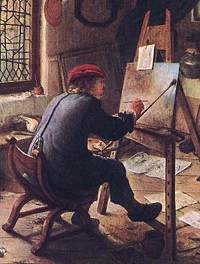
Adriaen van Ostade (Dutch, 1610-1685), detail
of The Artist's Workshop, oil
on canvas. The painter holds
a mahlstick so that its end rests near the edge
of the picture, supporting
and steadying the hand applying paint.
See beret, easel,
palette, and studio.
main case - Mother mold.
majolica or maiolica - A type of earthenware which originated during the Renaissance. It is coated with a tin glaze which produces the effect of a rich, enameled surface. Majolica is often lustered. Although the name majolica is derived from Majorca (an island east of Spain from which Italy imported early specimens from Islamic Spain), the name is often reserved for Italian examples.
(pr. mi:-AH-lə-kə)
Faience and Delftware have been made in imitation of majolica.
Also see antimony.
majuscule - A capital letter; literally a large letter. "Majuscule" looks like the complement to "minuscule," and the resemblance is no coincidence. "Minuscule" appeared in the early 18th century as a word for certain ancient and medieval writing styles which had "small forms." Eventually, "miniscule" came to be used for any lowercase letter, and gradually acquired a more general adjectival use for anything very small. "Majuscule" is the counterpart to "minuscule" when it comes to letters, but it never developed a broader sense (despite the fact that its Latin ancestor "majusculus" has the broad meaning "rather large"). The adjective "majuscule" also exists (as does "majuscular"). Not surprisingly, the adjective shares the noun's specificity, referring only to large letters or to a style using such letters.
(pr. MA-jə-skyool or mə-JUS-kyool)
Example:
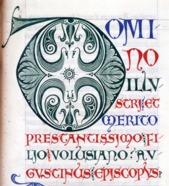
French, from Works of Saint Augustin, detail of a page
from a manuscript on vellum
in ten volumes, c. 1134. Library of Troyes, France. The Library
calls it manuscript 40. A large, decorated "D" majuscule
begins the text: "DOMINO ILLUSTRI ET MERITO PRESTANTISSIMO
FILIO VOLUSIANO AUGUSTINUS EPISCOPUS." (very loosely: "The
Lord is seen as He deserves to be, as on the speediest wings
by Bishop Augustin, His child." [email your version!]) This entire text is
comprised of majuscule letters, albeit none as colossal as the
first one. Click the link at the title to see more of this page,
which includes a section of miniscule letters.
Also see incunabulum, lowercase, miniature, minuscule, size, and uppercase.
makeup - See cosmetic.
![]()
![]()

makimono - A Japanese horizontal scroll.
(pr. MAH-kee-MOH-noh)
Also see Japanese art and kakemono.
malachite - A green mineral used in jewelry, intarsia, and as a pigment. Illustrated are some polished pieces, mared by malachite's typical multigreen patterning, and about half of their actual size. Chemically it is green copper carbonate, CuCO3 Cu(OH)2.
Examples:
![]()

![]()
Polished pieces of malachite, averag length 2 inches.
American, Faux Malachite, oil
on gessoed wood
panel. See faux
and marbling.
Related resource:
malanggan - Intricately carved Melanesian ceremonial sculptures — some call them masks — were made for elaborate rituals, some to memorialize the dead, some for a boy's initiation / circumcision rituals, and some, on a smaller scale, for other events. Different clans have owned different designs, and any artist commissioned to make a malanggan could work only designs owned by the patron's clan. Chicago's Field Museum says "Malanggan carvings took months to make, but after guests had viewed them, the carvings were burned or left to rot, breaking the connection with dangerous supernatural forces called into them when they were made."
Also see primitive.
malleable - Capable of being shaped or formed, whether by hand or with tools; plastic, pliable, pliant, ductile. Materials especially considered malleable are moist clay, modeling clay, polymer clay, warm wax, and molten glass and metals.
![]()

mallet - A wooden hammer
used to apply  force
to chisels in wood carving.
force
to chisels in wood carving.
Also see ballpein hammer, bush hammer, and claw hammer.
Manchu - A Chinese dynasty (also called Ching and Qing) which lasted 1644-1911.
Also see Chinese art.
mandala - Any of various radial geometric designs symbolic of the universe, traditionally used in Hinduism and Buddhism as an aid to meditation.
(pr. MAN-də-lə, MUN-də-lə)
Examples:

Borobudur —
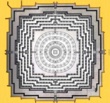 one of the most magnificent
Buddhist shrines in the world -- was built at the end of the
9th century by the Hindu kings of the Sailendra dynasty. Borobudur
is located 42 kms west of Yogyakarta, on the island of Java in
Indonesia.
one of the most magnificent
Buddhist shrines in the world -- was built at the end of the
9th century by the Hindu kings of the Sailendra dynasty. Borobudur
is located 42 kms west of Yogyakarta, on the island of Java in
Indonesia. The plan
for this stupa is a schematized representation of the cosmos,
a mandala. After visiting its lower terraces decorated
with bas-relief,
pilgrims attain the shrine's crowning
stupa, which symbolizes the Absolute.
Also see plan and representation.

China, Mandala, 1279-1368, Yuan
dynasty (1279-1368), silk, 33 x 33 inches (83.82 x 83.82
cm), Metropolitan Museum of Art, NY. See Chinese art, tapestry, and textile.

China, Mandala, 1330-1332, Yüan
dynasty, c. 1330-32, silk, metallic
thread, 96 5/8 x 82 1/4 inches (245.4 x 208.9 cm), Metropolitan
Museum of Art, NY. See Bodhisattva.

Tibet, Mandala of a Goddess, 16th-17th century,
opaque watercolor on cotton, 22 x 18 1/4 inches
(51.0 x 46.0 cm), Santa Barbara Museum of Art, CA.

detail: Marian Bantjes (Canadian, contemporary), Mandala, 2004, pattern produced with computer graphic software. If you visit Ms Bantjes' site, be sure to peruse her other patterns and paintings.
Related link:
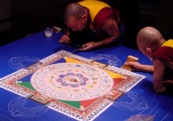 Construction
of the Medicine Buddha sand mandala at the Ackland Art Museum.
During one month in early 2001, the Venerable Tenzin Thutop and
the Venerable Tenzin Deshek, two Buddhist monks from the Namgyal
Monastery in Ithaca, New York constructed a five-and-a-half foot
Medicine Buddha sand mandala in the Ackland's Yager Gallery of
Asian Art. The museum's Web pages show photographs of numerous
stages of the construction. Ten weeks after the mandala's completion,
the monks dismantled it and deposited the sand in a body of water.
This process symbolizes the transience of life and the ideal
of nonattachment to the material world.
Construction
of the Medicine Buddha sand mandala at the Ackland Art Museum.
During one month in early 2001, the Venerable Tenzin Thutop and
the Venerable Tenzin Deshek, two Buddhist monks from the Namgyal
Monastery in Ithaca, New York constructed a five-and-a-half foot
Medicine Buddha sand mandala in the Ackland's Yager Gallery of
Asian Art. The museum's Web pages show photographs of numerous
stages of the construction. Ten weeks after the mandala's completion,
the monks dismantled it and deposited the sand in a body of water.
This process symbolizes the transience of life and the ideal
of nonattachment to the material world.
Also see curve, kaleidoscope, radial, and tondo.
mandapa - In Hindu architecture, an assembly hall, which is part of a temple.
(pr. man-DAH-pə)
mandated art curriculum - The curriculum or guidelines an art educator is required to follow by a school district or state government. Some school districts have their own curriculum or guidelines, while others follow state guidelines.
mandorla - A gloriole or glory when it surrounds the entire figure of God, Christ, the Virgin Mary, or a saint with a large oval of radiant light . Mandorla is the Italian word for almond. When it surrounds the head only, it is called a halo or nimbus. It indicates divinity or holiness.
(pr. man-DOR-lə)
Examples:

Unknown Artist of the School of the Laguna
Santero, Our Lady of Guadalupe, late 18th or early
19th century, food, gesso, water-based paint and gold leaf, 26
1/2 x 15 3/8 inches, Spanish Colonial Arts Society in Santa Fe,
NM. Scholars believe that an anonymous artist working in what
is now New Mexico at the end of the eighteenth century and beginning
of the nineteenth century was responsible for a large body of
similar work. They have named this unknown artist the Laguna
Santero, after a large altar screen in the church at Laguna Pueblo,
which they believe he painted.

Unknown artist, Our
Lady of Guadelupe, early 20th century?, lithograph.

Yolanda López (American, 1942-), Portrait of the Artist as the Virgin of Guadalupe,
1978, oil pastel on paper,
32 x 24 inches, collection of the artist. See Chicana
art.
Also see Gothic, Middle Ages, and votive.
manganese dioxide -
Example:

English, London, Tile, 1750, ceramic, delftware, manganese glaze,
4 15/16 x 5 1/16 x 5/16 inches, Minneapolis Institute of Arts.
Resources concerning
manganese dioxide:
See tile.
maniera greca - A formal Byzantine style that dominated Italian painting in the tweflth and thirteenth centuries. It's characterized by shallow space and linear flatness.
(pr. man-YAY-rə GREH-kə)
manifesto - A public declaration of principles, policies, or intentions. Although usually of a political nature, there is a history in art, especially in modernism during the first half of the twentieth century, of the spokesmen of various avant-garde movements publishing manifestos which declare their theories, motivations and direction, stimulating support for them or reactions against them. These movements have included Futurism, Rayonism, and Surrealism. To see an important example, read The First Surrealist Manifesto, 1924. (There is also a PDF version that's better for printing.)
maniplate, manipulation - To manipulate is to change or model by careful use of the hands; to manage shapes and forms in a space, less by additive or subtractive techniques than by moving things around.
Quote:
Related resource:
Also see aggregate, application, contrived, craftsmanship, emboss, fold, glaze, image manipulation, impasto, manual skill, modeling, pinch, plasticity, puppet, spontaneity, and temperature.
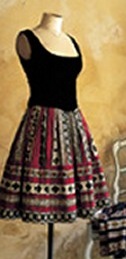
![]()

mannequin - A life-size full or partial representation
of the human figure.
Mannequins are often used for the fitting or exhibiting
of clothes. May also refer to
a jointed
model of a human figure
used by artists, especially
for use with drapery. This term is derived from an old Dutch word
for little person, mannekijn. It was absorbed into English
usage at about the same time that English speakers took from the
Dutch words the words "easel"
and "landscape."
(pr. MAN-nə-kən)
Examples of art in which mannequins appear:

Giorgio de Chirico (Italian, 1888-1978),
The Painter's Family, 1926, oil
on canvas, 146.4 x 114.9 cm,
Tate Gallery, London. Mannequins were a pre-World War I motif
for de Chirico. Here, several years after that war, he reimages
mannequins as members of a painter's family. The grouping is
reminiscent of traditional
depictions of the Holy Family.
The figures simultaneously
evoke a classical past and
an anxiety about the state of contemporary
art. See Metaphysical Painting.

Abelardo Morell (American, born Cuba, 1948-), The Metropolitan Opera: Costume Shop Mannequins, 2005, photograph of various sizes of mannequins used by costume makers.
Also see costume, Dutch art, model, nude, placeholder, puppet, and sculpture.
mantel or mantelpiece - The outer wall and casing of a fireplace or furnace. Sometimes simply called a mantel. Also called a chimneypiece or a fireplace surround. Easily confused with mantle.
Examples:

Augustus Saint-Gaudens (American, 1848-1907)
and John La Farge (American, 1835-1910), Mantelpiece, 1882, Metropolitan Museum
of Art.
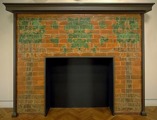
John S. Bradstreet (American), Grueby Faience
Company, Fireplace
Surround, 1902, 64 7/8 x 84 3/8 inches, Minneapolis Institute
of arts, MN. See faience and
Prairie style.
"Balthus" Balthasar Klossowski (French, 1908-2001), Figure in Front of a Mantel, 1955, oil on canvas, 75 x 64 1/2 inches (190.5 x 163.9 cm), Metropolitan Museum of Art, NY. See French art.
Also see architecture, decorative arts, and furniture.
mantle - A sleeveless protective outer garment or cloak. Easily confused with mantel or mantelpiece.
Also see chiton, costume, fibula, and himation.
manual skill - Dexterity. Educators refer to manual skill as well developed fine motor or small muscle control.
Also see craftsmanship, manipulate, and talent.
manufacture - To fabricate or process from raw materials, especially by means of a large scale industrial operation. And, either the act of manufacturing or the manufactured product itself.
Also see Art & Creative Materials Institute (ACMI), ASTM International (American Society for Testing and Materials), collectible, commercial art, commodity, interdisciplinary, paint-by-number, and Velcro ®
manuscript - See book, bookbinding, duodecimo, folio, illumination, incunabulum, lettering, octavo, quarto, rotulus, sextodecimo, signature, text, tricesimo-segundo, typography, and vicesimo-quarto.
https://inform.quest/_art